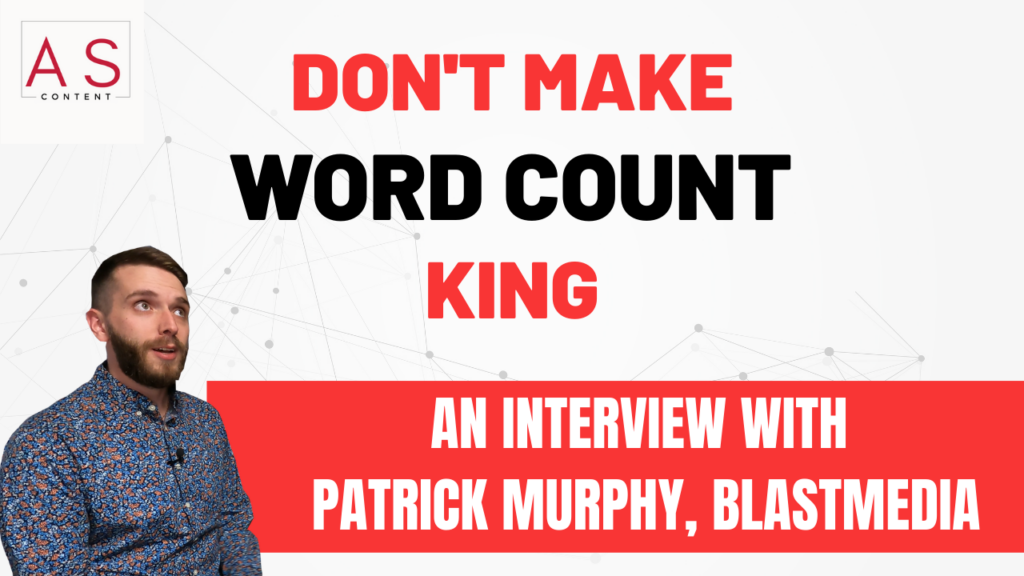Word count ain’t what it used to be. And if you’re relying on a hefty word count to do wonders for your content program, think again.
In a special edition of the Wednesday Word, Patrick Murphy, Senior PR Director at BLASTmedia, joins host Alex Sventeckis to revisit lazy language in PR writing and the misconception that longer pieces equate to higher quality. During the chat, Patrick shares more about how de-wordifying content with generative AI could pit it against SEO best practices, why concise writing and clear messaging matter more than ever, and lays out the need for a holistic communications plan beyond just press releases and social media posts.
Publishers take note: Word counts don’t dictate good content
Patrick knows firsthand from his work at BLASTmedia how word count requirements from publications can lead to padded content and lower-quality outcomes.
“Someone in the office had brought up, ‘I need just ten more words to reach the word count for this publication. And I don’t know what to add.’ And it was like, ‘Well, do you need those words? Does the byline actually need those words?’” Patrick says. “But the particular publication is notorious: They send back bylines if they don’t meet the word count rather than looking at the actual quality of the article.”
He believes this reinforces the misconception that longer pieces equate to higher quality, a thought pattern that manifests itself in many publications’ editorial guidelines. And for a long while, SEO rewarded these pubs for an article’s quantity of words, not as much for their quality.
But that’s changing. Patrick sees conflict arising in SEO’s future, as search engines like Google lean further into models like “Expertise, Authority, Trust” (E-A-T). Keyword stuffing and lazy language simply have no space in an article when engines dish out rewards based on the value the content provides.
“The longer the word count, the more likely you are to put in that lazy language — that fluff,” he says. “That is going to steal from your authority.”
ChatGPT enters the chat — and shapes more concise writing
In this emerging content environment, clarity in messaging and trimming unnecessary words will reign supreme. What will help us do that better, says Patrick, are generative AI tools like ChatGPT — which help him and his team write more precisely.
“I can review something and say, ‘Hey, if you cut this, this, and this, you can make this more concise, clear, and to the point.’ It’s great, but ChatGPT can do that same thing for you,” he says. “You can put something in and say, ‘I need this to be 500 words or less. I need this to be 400 characters or less.’ And it can help you do that and be the soft starter.”
As generative AI enters the fray — and how that changes SEO is still very much up in the air — Patrick also believes the fundamentals of great PR and marketing content remain unchanged. You still need to know your audience and tailor your language accordingly. And he encourages his people to seek feedback from each other to spot other areas to trim.
“If you have a second set of eyes, or when you can step away and come back to a piece, I think you can better identify those opportunities.”
An evolving content environment requires a fuller communications plan
Shorter content might give companies pause. After all, how else will everyone know about their amazing products and services if everything isn’t shoved into one giant press release?
Patrick suggests that because different guidelines apply to pitches, press releases, and articles, you can provide details selectively. Multiple concise content pieces across multiple media can weave a bigger web that captures more audiences.
“Let’s say there’s a lengthy list of new features. Do you have to go in-depth on all of them? Or can you point back to a landing page that provides more?” he says. “Spark some curiosity and get people to start digging on your website. Exploring beyond just your press release is going to lead to more value in the long run.”
Regardless of the media you choose, Patrick emphasizes the importance of quality over quantity. Just like the challenge with publications’ word count guidelines, you can’t let lazy language slip into your broader marketing work.
“Don’t make word count king.”
To hear more of Patrick’s insights, watch “Don’t Make Word Count King” on YouTube. And follow Alex Sventeckis Content Consulting for more Wednesday Word videos.

